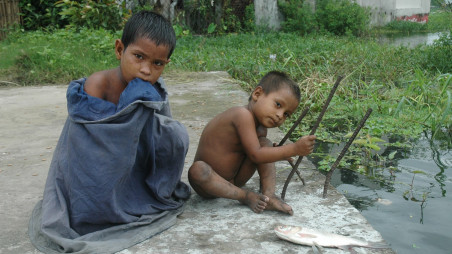Safety allocations not in line with poverty rates: WB

The poverty rate in the Barishal division is 26.5%, but beneficiaries of the government's social protection schemes have more than doubled the poor, meaning that the non-poor have outnumbered the deserving ones, according to a new World Bank report.
The number of beneficiaries in the Sylhet division is 172% of the poverty rate.
On the other hand, in the Rangpur division, identified as the poorest region with a poverty rate of over 47%, over 95% of the poor in the region have come under the social safety net.
The World Bank report shows the issue of poverty rate has got no importance in determining allocations for the government's social safety programmes.
The report titled "Adequacy of coverage, targeting and benefits of social protection programmes", which is yet to be published, shows that the number of poor people getting social protection benefits in Dhaka is 80% of the poverty rate - the lowest among the divisions.
The World Bank has prepared four policy papers on various issues related to social security schemes, including allocation of funds, targeting, selection of potential beneficiaries, transfer of funds.
According to all these papers, leaving many actual beneficiaries out of the social protection programmes and bringing the rich into the list is a commonplace. Besides, future investment, human resource development and employment are not given any importance while setting the targets of the programmes.
According to the policy papers, the number of children aged between zero and five in the country is 9%, but the number of such children in poor families is 13%. Such children receive only 1.6% of the age-based allocation for social security.
Moreover, the number of people aged 60 or above is 8% of the total population, but they are enjoying 72% of the age-based allocation.
"This is particularly worrisome, as pregnancy and the first few years of life are so critical to cognitive development and later productivity. The importance of investments in this age group has been underlined in the NSSS [National Social Security Strategy], and is the object of concerted efforts to develop and adopt uniform principles of design for a comprehensive Child Benefit Program," one of the reports revealed.
"To this end, coordinated intervention across various government agencies working with the young children is critical," it added.
The report expressed concern over the long delay in allocating funds for social security programmes.
It takes an additional two to six months for old-age allowance to reach beneficiaries. This resulted in a loss of 2.25% or Tk54 crore of the total allocation in 2019.
The report said it takes up to four months for allowances under the Employment Generation Programme for the Poorest (EGPP) to reach beneficiaries, while the beneficiaries of Maternal Health Voucher Scheme (MHVS) need to wait up to 13 months.
The report said that such delays led to a loss of Tk87 crore, if calculated at 7% interest, in FY19. The amount will go up further if the inflationary loss owing to the delay on the part of beneficiaries is calculated.
Domestic and foreign research firms have long been expressing concern over inconsistencies in social security programmes.
According to a Centre for Policy Dialogue (CPD) research report last year, 65.6% beneficiaries of the government's social safety net programmes are non-poor families.
"Social safety net programmes in Bangladesh are able to cover only a proportion of the total poor population. Only 32.5% of poor households received some forms of assistance, while about 19.8% among the non-poor were included in such programs," revealed the report titled "Efficiency of Delivering Social Protection Programs in the North-West Region. "
The report based on the five northern districts said about 67.8% of beneficiaries are from non-poor families, while only 32.2% of them are from poor families. Some 41.5% of beneficiaries for the maternity allowance are from poor families, while 58.5% of them are from non-poor families.
Mustafizur Rahman, distinguished fellow at the CPD, said without considering the poverty, funds for social safety programmes are allocated as per the number of people in a particular region, resulting in higher allocation in districts with lower poverty.
"A pie of the allocation meant for the poor has long been going into the rich's pockets, depriving actual beneficiaries as there is no database of poor people," he also said.
This issue has been under discussion for a long time. Researchers have been advocating for a reduction in flaws and corruption in the social safety net. However, no effective initiative has been taken in this regard yet.
He suggested streamlining the safety net and creating a proper database
The report recommended allocating in line with the number of poor in different categories.
"Deploy a streamlined model that can be scaled-up to capitalise on the demographic dividend, both in rural and urban areas, with a focus on youth and women," it recommended.
The report also said Bangladesh Bureau of Statistics' (BBS) poverty maps can be used to allocate resources by regions, districts, or even upazilas. This is already the case for EGPP, and for expansion of the old-age and widow allowances to the 112 poorest upazilas, as part of the government's Covid-19 response. Other large programmes could consider using this tool.
The government is implementing social safety net programmes worth Tk107,614 crore for the current fiscal year, which is 3.11% of the GDP. The allocation for the programme was Tk95,683 crore in the last fiscal year and increased by 12.47%.
Pension for retired government employees and their Families accounts for about 36% of the programmes revealed in the report of the World Bank.



 Keep updated, follow The Business Standard's Google news channel
Keep updated, follow The Business Standard's Google news channel















